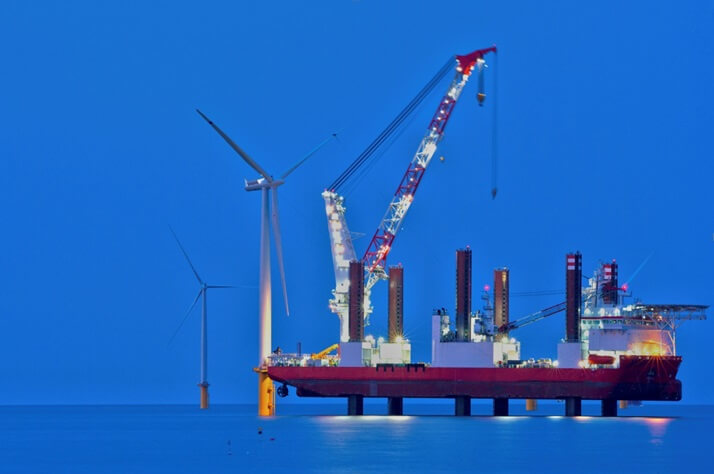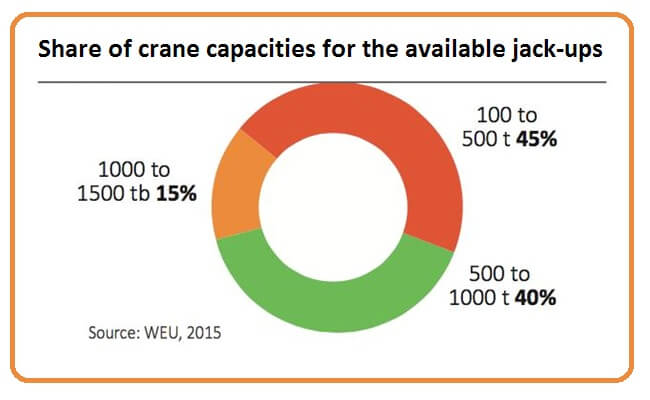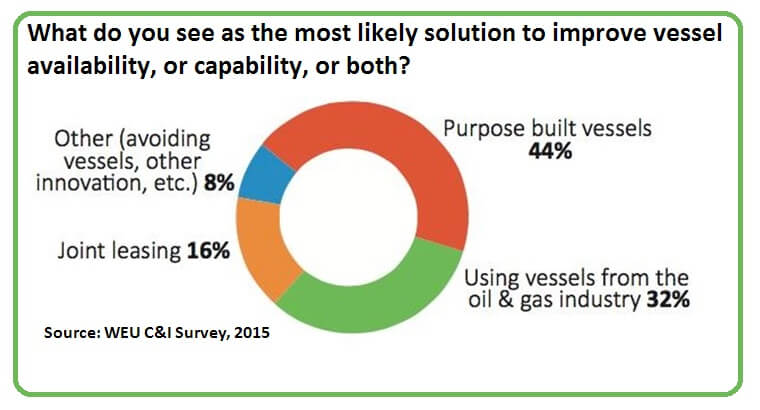By Jason Deign
Offshore project developers face a limited supply of vessels capable of installing new higher capacity turbines in deeper waters until the arrival from about 2018 of a new generation of purpose-built installation vessels, according to Wind Energy Update’s Offshore Foundations and Supporting Structures Report 2015.
The European offshore wind industry has a fleet of more than 75 vessels to support it, but almost half of the jack-up vessels in use are not capable of installing the 8-MW turbines now planned for some projects, according to the newly-published study.

The rapid rise in turbine size now requires support from installation technologies that are in short supply. (Photo: Steve631)
Around half the fleet is not equipped to handle deep-water monopile installations, limited to a maximum depth limit of 30 metres for 3.3-MW turbines.
Developers continue to convert existing vessels not originally designed to handle the new higher-capacity structures, while uncertainty over the regulatory support for future offshore wind growth slows the development of new purpose-built vessels.
“Multi-purpose vessels serving the offshore wind industry are partially converted to match the specific requirements of this sector, often hired for short periods of time and therefore not adapted solely for use in wind farm installation activities,” the report said.
“One way or another, these vessels are not ideally designed and/or equipped for optimal turbine, foundation or transition piece installation and their performance in the execution of installation activities is therefore not ideal.”
Currently only around a dozen vessels are fully adapted for work in the offshore wind industry, the report said, and only seven in the world are capable of handling monopiles weighing more than 1,000 tons.
“Such limited availability of suitable vessels, even for relatively lighter XL monopiles, is likely to create installation bottlenecks, whilst the lack of competition among vessel suppliers will probably have negative effects on the pursuit to lower project costs,” said the report.
Shipbuilders are responding to the demand for purpose-built installation vessels with a new generation of ships designed specifically for offshore wind, including jack-up vessels that follow guidelines set out by the certification body DNV GL in 2010.
The specification for wind turbine installation jack-up vessels takes account of the fact that they have specific needs, different from traditional oil and gas-focused offshore operations.
Compared to existing vessels used in the wind sector, these ships have faster jacking speeds and the ability to operate in deeper waters, up to depths of 60 m with a jack up 15 m above sea level.
In addition, these and other, free-floating, vessels are larger than many of the ships currently in service, typically with accommodation for more than 100 people, and have dynamic positioning capabilities along with greater deck space and storage capacity.
The new purpose built vessels are also faster and more able to handle adverse weather conditions. This makes them more suited for the installation of XL monopiles required for larger turbines in greater depths further out to sea.
Examples of this new generation of vessels include W3GMarine’s OWTIS, with 4,500 m² of free deck space and a lifting capacity of up to 1,500 tons or Vuyk Engineering’s Vuyk VVV, with 4,700 m² of deck space and 3,000 tons lifting capacity.
While these purpose built vessels might typically command higher day rates than other types of vessel, there is broad agreement across the industry that their ability to cut installation times makes them more cost-effective than general-purpose ships.
 In a 2015 construction and installation markets survey by Wind Energy Update, 44% of respondents said purpose-built vessels would be the best option for improving vessel availability and capability, compared to 32% citing the use of oil and gas sector ships.
In a 2015 construction and installation markets survey by Wind Energy Update, 44% of respondents said purpose-built vessels would be the best option for improving vessel availability and capability, compared to 32% citing the use of oil and gas sector ships.
This preference for purpose built vessels is supported by early experience. In September 2012, for example, a dynamically positioned, heavy-lift, free-floating vessel called the Jumbo Javelin set a new record for turbine installations by placing three transition pieces a day at Denmark’s Anholt wind farm.
However, lead times involved in vessel construction are around two-to-four-years, and firm delivery dates are often delayed. Most new ships with these kinds of capabilities will not enter into service until after 2018.
OWTIS, for instance, is not expected to launch until 2018 at the earliest, while Vuyk VVV is still at the concept stage. Of 22 wind industry support vessels known to be under construction or in planning, only half a dozen have firm delivery dates.
One issue for the industry is that doubts over the future regulatory framework for offshore wind power tariffs can deter investment needed for the construction of new vessels.
If wind farm construction drops off then so will demand for vessels, and with a cost of up to almost $280 million per vessel, investors need to be assured that their assets will be fully utilized once they leave the shipyard.
Uncertainty on this point has already led to delays in some vessel orders. For example, construction of the US’ first jack-up barge, the RD MacDonald, is currently on hold due to lack of progress on US offshore wind projects.
“Considering the shorter lead time and lower investment costs, conversions of existing vessels are likely to dominate the foundation installation market for the near future.” the Offshore Foundations and Supporting Structures Report said.
Filed Under: Construction, News, Offshore wind




